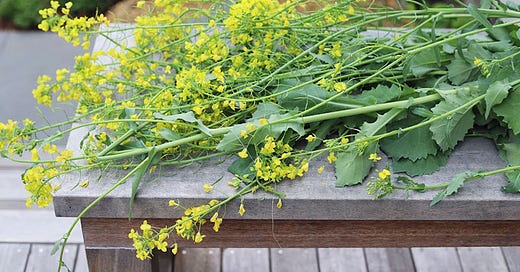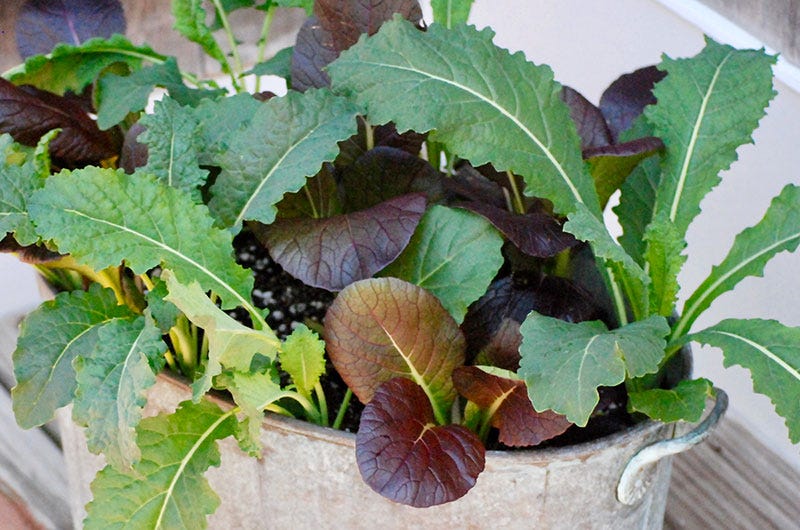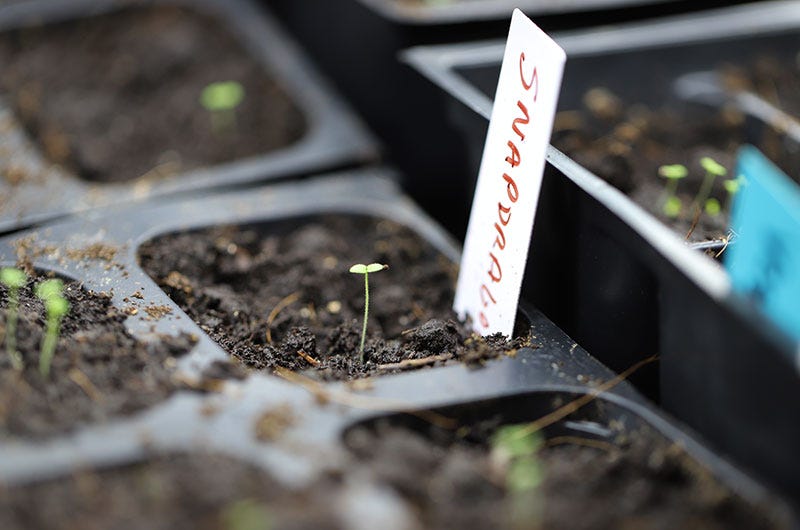Flip Sides of the Faith Coin
Tending a tiny seed is as much about letting go as it is about trust and hope.
When I was a little girl, my friend Eliza’s grandmother gave each of us a little necklace with a glass charm hanging from it. Inside the charm was a mustard seed. Along with the necklace came a small medallion that read, “If you have faith as small as a mustard seed, nothing will be impossible for you.” (A rough translation of Matthew 17:20-21.)
I see on Etsy that these necklaces are still out there. Of course! How many millions of dollars have been made on Bible verses? And I guess we could all turn our noses up at them for being one more Christian cliché.
But I’m not going there. Because Eliza and I liked those necklaces. As I recall, we both donned them eagerly and wore them until they were too small for our no-longer-tiny necks. I think mine may have broken, the glass bead rolling under my twin bed into a dusty corner to lay there, dormant, for a very long time.
The necklaces were something we shared, something “Grandma” gave us. Grandma, aka Eleanor, was a tall, thin lady with a wry smile and a good sense of humor. Very smart and somewhat reserved, she was nevertheless warm and welcoming. In her rambling Queen-Anne style home, there was a room full of toys on the second floor, just at the top of the front staircase at the near end of a very wide and long hallway. I remember that room and that big house so well, as there were many afternoons when Eliza and I landed there to play, our mothers off on some important mission, I’m sure.
Looking back, I find it touching that Grandma felt it important not only to plant a tiny seed of faith in our young minds, but also to say (in a broader sense) to two little girls: “You can do anything if you put your heart and soul into it.”
In those days, we went to church with our families every Sunday, and when it came time for the kids to leave the service and walk over to the Sunday school building, Eliza and I would occasionally detour out the side door and conveniently never make it to Sunday school. We’d manage to rendezvous with our parents after the coffee hour without them realizing what we’d done. I’d like to say this truancy was all Eliza’s idea, but, well, yes, actually, it was all Eliza’s idea!
We outgrew our mustard-seed necklaces; we outgrew Sunday school. But somehow a tiny grain of faith stayed with me. Just enough to get through the seemingly insurmountable challenges as years went by.
Granted, it took me decades – and a lot of digging in the dirt – to even understand what the whole deal with the mustard seed was. Mustard seeds truly are tiny — not as tiny, as say, poppy seeds, but pretty darn small. And guess what? They grow into big plants.
The first time I zipped open an envelope of mustard seeds, I recognized my old friend, but he was somehow even smaller than I’d remembered – and had a lot of company. I sprinkled the miniature orbs into a shallow trench dug in rich, loamy soil on a cool spring day, and in only a few days I had sprouts; in a few weeks I had baby greens, in a couple months I had giant leaves, followed by tall, reedy, flower stems in the high heat of summer.
And this cultivated mustard is nothing compared to wild mustard. Maybe you’ve seen the yellow swaths of blooming wild mustard running rampant through abandoned fields and along country roads. It can grow up to nine feet tall. And if you were to look at it closely, you’d see that the yellow flowers are cross-shaped. Hence the family name, Cruciferae. A crucifer is one who carries a cross – perhaps why the mustard seed makes multiple appearances in the New Testament. Though it doesn’t seem fair that mustard seed got all the limelight when kale and cabbage and Brussels sprouts are Cruciferae, too.
Regardless of the type of mustard, this is clearly a plant that turns tiny into mighty. So okay, I get it – if the mustard can grow that big, you too can do a lot with a little. Though I don’t think that’s exactly what Jesus meant. (Uh oh, here is where you should be thinking, “Does she have any idea what she’s talking about?” And the answer would be no. I am not a Biblical scholar like my high school classmate and Oxford professor of theology Susan Blackburn Griffith – Susan, HELP! – though I did manage to co-major in religion in college and promptly forget nearly 100 percent of what I learned while in a haze of keg beer and Mai Tais.)
So truthfully, what the internet tells me Jesus meant is that even a tiny bit of faith —faith as small as a mustard seed — is a hundred times better than none at all. If the passage from Matthew were put back into context, we would see that Jesus was admonishing his disciples for not being able to pull off something he could clearly do with the snap of his fingers, all because they didn’t have an iota of faith.
Admonishing is verboten here at Sixburnersue, and it’s hard enough to try and define what faith is and how you even latch on to it, much less why you wouldn’t if you could. (If diving into this quagmire appeals to you, here are 13,000 fascinating words on that subject — what is faith? — from the Stanford encyclopedia of philosophy.)
So I thought I’d just say that as a gardener, this mustard seed thing makes a lot of sense to me.
Because I feel like when you grow stuff, you get to practice faith every day. You have to learn to let go. And to trust. You get to experience grace and ultimately witness miracles. Along the way you get to pray a lot.
I was thinking about all this when I planted snapdragon seeds last week. They are so tiny they make mustard seeds look like footballs. In fact, they’re so small that it’s hard to distinguish them with the naked eye – like dust motes you can’t see until they hang together and form dust bunnies. The only way to plant snapdragon seeds evenly is by using a wet toothpick to transfer them, one at a time, to the waiting soil.
I haven’t had huge success with starting snapdragons from seed in the past. (And why would one even bother, you ask? Aren’t there perfectly good snapdragons for sale at the nursery? Well, yes, if you like short stems with flowers in primary colors. If you want long luxurious stems smothered in creamy peach and dreamy blush flowers, you have to start the seed yourself.) But I was determined to get it right this year, so I studied up on how to do it.
I got those babies into the soil, watered them evenly, covered the flat with a plastic dome, and put it in a cool spot in the dark. Then I waited. And stared. And prayed.
Every morning for a week I padded down the stairs and headed for the first-floor bedroom where the seed-starting operation has taken over. (If you think that’s bad, the first-floor bathroom shower is filled with tubs of potting soil and piles of pots and flats.) I took off the plastic dome and searched for signs of life. Nothing, day after day.
But I had faith.
A sea of teeny tiny snapdragon sprouts popped up on the eighth day. I rejoiced and moved the seedlings under the lights, where I hope they’ll flourish until it’s time to plant them outside, where they’ll eventually grow, miraculously, a thousand times bigger than the tiny seed they came from.
It doesn’t always work like that. A 72-cell flat of lettuce I planted a couple weeks ago has produced only six lettuce seedlings, and it’s now clear that it ain’t gonna produce any more. The seed was mostly older (first problem); I started the flat on heat (they don’t like too much heat); I probably overwatered them; I moved them to the hoop house where the temperature swing has been radical. I haven’t been kind to them. But I know I have to let them go now. Instead of continuing to fret over them, I’m going to start from scratch, and trust that not making the same mistakes is going to produce a good outcome.
It seems to me that letting go, which is all about confronting fear, and trust, which is all about embracing hope, are just flip sides of the same faith coin. You get to practice both in the garden, building up your faith muscle so it’s ready when the big stuff comes along. And this is the cool thing about faith: When you let go and trust someone or something else with the reins, you get the peace that quiets inner voices and makes room for beauty and growth. If a mustard seed can do it, so can we.
…….
Listen to “The Blessing”
Speaking of my friend Susan Griffith, this is a You Tube video she links to from her Instagram bio. I had never watched it until yesterday, and it is now one of my favorite things in the whole world. Made during the pandemic lockdown in the United Kingdom, it’s a multi-voice recording of “The Blessing,” sung by individuals and choirs from more than sixty churches across the UK. You don’t have to have any faith, be of any faith, or even care about faith to be moved by this.
(FYI, the embedded video link will currently only work if you are reading the newsletter on your desktop as opposed to your phone.)










Wonderful post. Thank you from this partial-to-mustard-seed-agnostic-but-convinced-of-something person. 🙏🏻
Than you, great post! And the link to Blessing video worked perfectly from my phone!